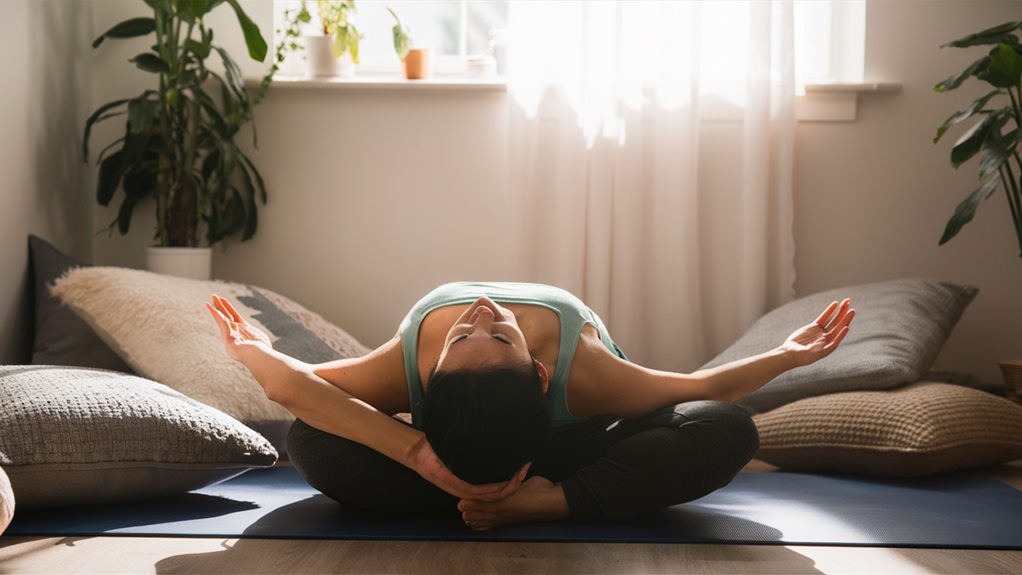If you're looking for effective breathing exercises to relieve stress, consider these five techniques. Start with Diaphragmatic Breathing to engage your diaphragm for deep relaxation. The 4-7-8 Breathing Technique can help you calm your mind and slow your heart rate. Box Breathing adds structure, improving focus while reducing anxiety. Alternate Nostril Breathing balances your body and mind, enhancing your overall well-being. Finally, Guided Visualization Breathing combines deep breaths with mental imagery for a calming effect. Each technique offers unique benefits that can transform your stress levels significantly. You might find even more helpful tips ahead.
Key Takeaways
- Diaphragmatic Breathing: Promotes deep relaxation by engaging the diaphragm, enhancing emotional health and alleviating muscle tension.
- 4-7-8 Breathing Technique: Induces relaxation and sleepiness, effectively managing anxiety and panic attacks while improving respiratory function.
- Box Breathing: Structured method that calms the mind, reduces anxiety, and enhances focus through controlled breathing patterns.
- Alternate Nostril Breathing: Balances brain hemispheres, reduces stress and anxiety, and fosters a sense of inner peace and clarity.
- Guided Visualization Breathing: Combines deep breathing with mental imagery for stress reduction, promoting calmness and positive affirmations.
Diaphragmatic Breathing

Diaphragmatic breathing, often referred to as belly breathing, can help you tap into a powerful tool for managing stress. This technique encourages deep relaxation by engaging your diaphragm, allowing for fuller, deeper breaths. When you breathe this way, you activate the body's natural relaxation response, which counteracts stress and anxiety. Additionally, just as selecting the right resistance bands is essential for effective workouts, choosing the right breathing technique is vital for your overall mental well-being.
To practice diaphragmatic breathing, find a comfortable position—whether you're sitting or lying down. Place one hand on your chest and the other on your belly. As you inhale deeply through your nose, focus on expanding your belly rather than your chest. You'll notice that your hand on your belly rises while the one on your chest remains relatively still. This simple shift signifies that you're engaging in the mind-body connection, aligning your breath with your body's natural rhythm.
Exhaling slowly through your mouth, allow your belly to fall. Repeat this cycle several times. You'll likely feel more centered and in tune with your body, which can help you release tension.
Incorporating diaphragmatic breathing into your daily routine can greatly enhance your overall well-being. Whether you're facing a stressful situation or just need a moment of peace, this practice fosters a sense of belonging within yourself. As you nurture this connection, you'll find that you're better equipped to face life's challenges with calm and resilience. Embrace this technique, and discover the profound impact it can have on your stress levels and emotional health.
4-7-8 Breathing Technique

The 4-7-8 breathing technique is a simple yet effective method to promote relaxation and reduce stress. This technique encourages you to focus on your breath, making it a valuable mindfulness practice. By incorporating this technique into your daily routine, you can enhance your stress management techniques and cultivate a sense of calm. Additionally, just as providing fresh water can improve a pet's well-being, regular practice of breathing exercises can notably enhance your overall mental health health benefits of hydration.
To start, find a comfortable seated position. Place the tip of your tongue against the roof of your mouth, just behind your front teeth. Begin by exhaling completely through your mouth, making a whoosh sound. Then, close your mouth and inhale quietly through your nose for a count of four. Hold your breath for a count of seven, allowing your body to absorb the oxygen. Finally, exhale through your mouth for a count of eight.
Repeat this cycle four times. You'll find that with each round, your heart rate slows and your mind begins to quiet. This technique is perfect for those moments when stress feels overwhelming, providing a moment of peace in your day.
As you practice the 4-7-8 technique regularly, you'll likely notice improvements in your overall well-being. It's an empowering tool that fosters a sense of belonging within yourself, helping you connect with your inner calm. So, the next time stress creeps in, remember this powerful breathing exercise. You've got the ability to regain control and embrace tranquility.
Box Breathing

Utilizing a structured approach, box breathing is an effective technique for managing stress and enhancing focus. This simple yet powerful method helps you regain control over your breath, making it an excellent addition to your relaxation techniques. By practicing box breathing, you can experience the meditation benefits that come from calming your mind and body.
Here's a quick overview of how box breathing works:
| Step | Action | Duration |
|---|---|---|
| Inhale | Breathe in deeply | 4 seconds |
| Hold | Hold your breath | 4 seconds |
| Exhale | Breathe out slowly | 4 seconds |
| Hold | Hold your breath | 4 seconds |
To perform box breathing, find a comfortable position and close your eyes. Start by inhaling deeply through your nose for four seconds. Hold your breath for another four seconds, allowing yourself to feel the pause. Then, exhale slowly through your mouth for four seconds, and once again hold for four seconds before repeating the cycle.
This rhythmic pattern not only helps reduce anxiety but also fosters a sense of belonging as you connect with your breath. With each cycle, you'll feel more grounded and present. Integrating box breathing into your daily routine can greatly enhance your overall well-being, making it an essential tool in your stress relief arsenal. So why not give it a try?
Alternate Nostril Breathing

After mastering box breathing, you might want to explore another powerful technique called alternate nostril breathing. This ancient practice, often used in yoga, can help restore balance and calm your mind. It emphasizes the mind-body connection, allowing you to feel more grounded and connected to yourself and the world around you. Additionally, incorporating calming practices into your routine can enhance your overall well-being, similar to how choosing the right tools, like top dry erase boards, can improve communication effectiveness.
Here's how to practice alternate nostril breathing:
- Find a Comfortable Position: Sit cross-legged or in a chair, with your back straight and shoulders relaxed.
- Use Your Right Hand: Place your thumb over your right nostril and your ring finger over your left nostril.
- Begin the Cycle: Close your right nostril with your thumb and inhale deeply through your left nostril. Once you're full, close the left nostril with your ring finger.
- Exhale and Switch: Release your thumb and exhale through the right nostril. Inhale through the right, close it, and exhale through the left.
Repeat this cycle for five to ten minutes.
Practicing alternate nostril breathing offers numerous yoga benefits, including increased focus and reduced stress. As you synchronize your breath with this technique, you'll nurture that essential mind-body connection, enhancing your overall well-being. With regular practice, you'll likely find a deeper sense of calm and clarity in your daily life. So, take a moment for yourself and embrace the tranquility this technique can bring!
Guided Visualization Breathing

When you're feeling overwhelmed, guided visualization breathing can provide a serene escape from stress. This mindfulness practice combines deep breathing techniques with mental imagery, helping you tap into a sense of calm and focus. By picturing a peaceful scene—like a tranquil beach or a lush forest—you engage your imagination while promoting a relaxation response in your body.
To get started, find a comfortable place to sit or lie down. Close your eyes, and take a deep breath in through your nose, letting your abdomen expand. As you exhale slowly through your mouth, visualize your chosen serene location. Imagine the sounds, colors, and scents around you. This mental imagery not only enhances your experience but also fosters stress reduction, allowing you to disconnect from your worries.
As you continue this practice, synchronize your breath with your visualization. Inhale deeply, imagining the soothing air filling your lungs, and exhale any tension, picturing it dissipating into the environment around you.
You might repeat positive affirmations during this exercise, reinforcing feelings of peace and belonging.
Guided visualization breathing can be a powerful tool in your stress management toolkit. By regularly incorporating this mindfulness practice into your routine, you'll likely find it easier to cope with daily pressures and foster a greater sense of well-being. Remember, you're not alone on this journey; many share these moments of seeking calm amidst life's chaos.
Frequently Asked Questions
How Often Should I Practice Breathing Exercises for Maximum Benefit?
To maximize the benefits of breathing exercises, aim to practice them daily. Consistent frequency enhances the effectiveness of various techniques, making you feel more grounded and relaxed over time. Even just a few minutes each day can yield significant improvements in your well-being.
You'll notice a difference in how you handle stress and anxiety, fostering a sense of belonging and connection within yourself. So, make it a part of your routine!
Can Breathing Exercises Help With Anxiety and Panic Attacks?
When you feel the storm of anxiety approaching, remember your breath is a gentle anchor. Breathing exercises can enhance your mind-body connection, turning chaos into calm.
By practicing mindful breathing patterns, you invite relaxation techniques into your routine, easing panic's grip. With each inhale, you create space for peace, and with every exhale, you release tension.
Embrace these moments of mindfulness, and you'll find a sense of belonging within yourself.
Are There Any Risks Associated With Breathing Exercises?
Yes, there are potential side effects associated with breathing exercises. Some people might experience dizziness, lightheadedness, or increased anxiety if they overdo it or use improper techniques. To [GUARANTEE] safety, you should take precautions like starting slow, finding a comfortable position, and stopping if you feel unwell.
Listening to your body is key. Remember, it's about finding what works best for you, so don't hesitate to adjust your practice as needed.
When Is the Best Time to Practice Breathing Exercises?
Timing's key to tapping into the transformative power of breathing exercises. Start your morning routine with a few minutes of focused breaths to energize your day.
Then, as bedtime approaches, embrace calming techniques to promote peaceful sleep. These moments of mindful breathing create a comforting cadence in your life, helping you feel more centered and connected.
Can Children Practice Breathing Exercises for Stress Relief?
Absolutely, children can practice breathing exercises for stress relief! These techniques offer numerous benefits, helping them learn relaxation and emotional regulation from a young age. You can introduce simple methods like deep belly breathing or counting breaths, making it fun and engaging.
Encouraging your child to take a few minutes each day to focus on their breath can create a sense of calm, fostering resilience and coping skills they'll carry into adulthood.
Conclusion
Incorporating these breathing exercises into your daily routine can greatly reduce stress and promote relaxation. Did you know that studies show deep breathing can lower cortisol levels by up to 30%? By practicing techniques like diaphragmatic breathing or box breathing, you're not just calming your mind—you're also supporting your overall well-being. So, take a moment each day to breathe deeply, and you'll likely notice a positive shift in your mood and stress levels.

